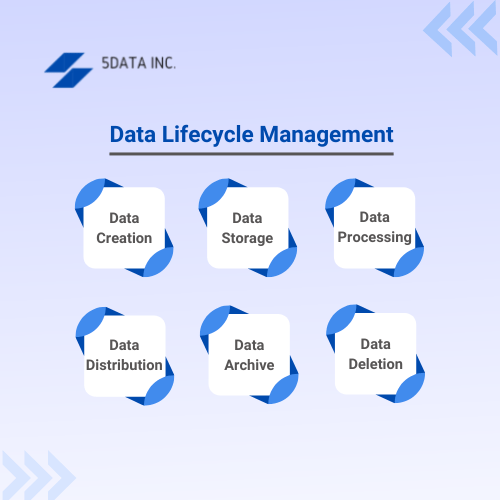What we cover in this blog
Stages Of Data Lifecycle Management
There are a few essential stages of data lifecycle management-
Data Creation - The data lifecycle starts with data collection or creation. Data is abundantly available everywhere. However, organizations should collect data based on its quality and importance to their business. Data can be extracted from mobile and web applications, surveys, forms, etc.
Data Storage - Once the data is created, storing plays another important role as it helps to access the data whenever necessary. Data can be stored using different mediums like computers, external storage devices, or the cloud. Creating a backup for stored data saves the organization during data deletion, corruption, or malware attacks.
Data Processing – For the raw data to be productive, it has to be analyzed, processed, and refined further. As a part of the data processing workflow, data is validated, filtered, reformatted, analyzed, and presented as usable information.
Data Distribution - Once the data is analyzed, the next big step is data distribution; this enables organizations to define who uses the data and to what extent. This is the most crucial step where data delivers its full business value; it plays a major role in business decision-making and communication with various stakeholders.
Data Archive - Data archiving is essential to the data management lifecycle. In fact, it is the activity during which data is often examined, cleansed, and preserved. This process guarantees data security by preserving and making information available for future use. Archived data is, in essence, a gold mine.
Data Deletion -This is the final phase of DLM, where the data is deleted and destroyed securely from the records. Too much unrequired data will consume storage space and become a burden for the business. Hence the data is deleted from archives too when it exceeds the required retention period.

Advantages Of Implementing Data Lifecycle Management In Your Organization
Compliance - Every business has its own rules and regulations for data retention and compliance. A proper DLM strategy helps businesses comply with data privacy laws, regulations, and standards. For instance, banks ought to maintain records for a specific period per the Bank Secrecy Act. Maintaining data per the rules is arduous. A sound DLM can aid organizations in complying with the rules and regulations promptly.
Data Protection - Given today’s threat landscape, managing data and its security is the top priority for corporate executives and IT workers. DLM assists enterprises in protecting their data from loss, destruction, cyberattacks, and other threats. It allows organizations to choose how their data is processed. This helps in managing data, primarily – sensitive information. Sensitive data is required to be protected at all costs.
Helps In Collecting Accurate Data - Today’s businesses are data-driven. Data is critical in driving an organization’s strategic ambitions. As a result, businesses must verify that their company’s data is clean, up to date, and legitimate. An effective DLM strategy guarantees that the data made available to users is correct; this is the essential feature of data lifecycle management. DLM aids in preserving data quality throughout its lifespan, allowing for process optimization and increased efficiency.
Aids Big Data Analytics – Businesses use data to fine-tune their activities. A good data lifecycle management makes the data set trustworthy and safe and aids in complying with data handling standards. This assurance can help better analysis of the data, furthering the goal of data lifecycle management. Optimum data availability is essential for the growth of a business.
Helps In Growth – So, this last benefit is, in essence, derived from the above four. Since the business is working with proper data management and distribution, it will aid the organization’s operational capacity and improve products and customer experience. This is bound to bring more revenue and ultimately would aid the business’s growth. Now, all this can only be possible if data is used properly.
Conclusion
While corporations recognize the value of data; securing, maintaining, and managing data is a different ball game. Therefore, to ease the process, you can choose one of the best data collection and data management service providers, 5DataInc. We are equipped with the tools you need to store, analyze, and distribute data.
Data lifecycle management is an asset every company uses for their business growth and development. So, what are you waiting for? Contact us and get along with your data lifecycle management strategy easily and efficiently.

Annanya Adyasha
Author
